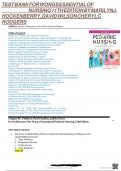Exam (elaborations)
TEST BANK : Wong’s Essentials of Pediatric Nursing, 11th Edition by Marilyn Hockenberry, Cheryl Rodgers, Verified Chapters 1 - 31, Complete Newest Version|100%verified
Course
Wong’s Essentials Of Pediatric Nursing 11th Editi
Institution
Wong’s Essentials Of Pediatric Nursing 11th Editi
TEST BANK : Wong’s Essentials of Pediatric Nursing, 11th Edition by Marilyn Hockenberry, Cheryl Rodgers, Verified Chapters 1 - 31, Complete Newest Version|100%verifiedTEST BANK : Wong’s Essentials of Pediatric Nursing, 11th Edition by Marilyn Hockenberry, Cheryl Rodgers, Verified Chapters 1 - 3...
[Show more]
Preview 4 out of 383 pages
Uploaded on
September 16, 2024
Number of pages
383
Written in
2024/2025
Type
Exam (elaborations)
Contains
Questions & answers
Institution
Wong’s Essentials Of Pediatric Nursing 11th Editi
Course
Wong’s Essentials Of Pediatric Nursing 11th Editi
$18.99
100% satisfaction guarantee
Immediately available after payment
Both online and in PDF
No strings attached
Stuvia.com - The Marketplace to Buy and Sell your Study Material ! ! ! ! ! ! ! ! ! !




